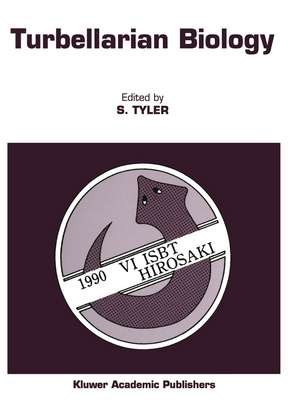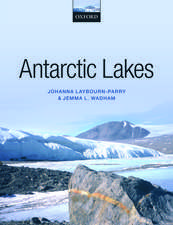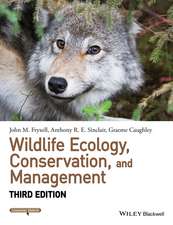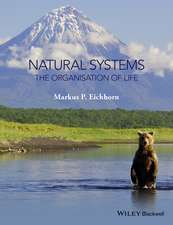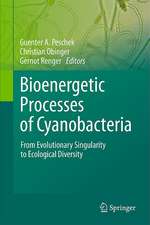Turbellarian Biology: Proceedings of the Sixth International Symposium on the Biology of the Turbellaria, held at Hirosaki, Japan, 7–12 August 1990: Developments in Hydrobiology, cartea 69
Editat de Seth Tyleren Limba Engleză Paperback – 20 noi 2013
But turbellarians are more than just taxonomic curiosities. They have served as illustrative models in research on a variety of basic life processes. For example, their high capacity for regeneration has made them the subject of a large literature in developmental biology, the occurrence of mixoploidy and other karyological oddities among turbellarians has been important in understanding evolution of the genome, and the fine structure and biochemistry of the nervous system in turbellarians is revealing important principles of the organization of so-called primitive neural systems.
Din seria Developments in Hydrobiology
- 18%
 Preț: 1229.10 lei
Preț: 1229.10 lei - 18%
 Preț: 959.98 lei
Preț: 959.98 lei - 18%
 Preț: 963.91 lei
Preț: 963.91 lei - 15%
 Preț: 648.24 lei
Preț: 648.24 lei - 15%
 Preț: 637.89 lei
Preț: 637.89 lei -
 Preț: 378.25 lei
Preț: 378.25 lei - 15%
 Preț: 644.95 lei
Preț: 644.95 lei - 18%
 Preț: 952.09 lei
Preț: 952.09 lei - 20%
 Preț: 558.87 lei
Preț: 558.87 lei - 18%
 Preț: 1833.65 lei
Preț: 1833.65 lei -
 Preț: 393.59 lei
Preț: 393.59 lei -
 Preț: 406.54 lei
Preț: 406.54 lei - 18%
 Preț: 1226.73 lei
Preț: 1226.73 lei - 18%
 Preț: 956.99 lei
Preț: 956.99 lei -
 Preț: 388.87 lei
Preț: 388.87 lei - 24%
 Preț: 1060.53 lei
Preț: 1060.53 lei - 18%
 Preț: 1229.28 lei
Preț: 1229.28 lei - 20%
 Preț: 569.31 lei
Preț: 569.31 lei -
 Preț: 368.79 lei
Preț: 368.79 lei - 24%
 Preț: 817.48 lei
Preț: 817.48 lei - 18%
 Preț: 958.25 lei
Preț: 958.25 lei - 18%
 Preț: 953.03 lei
Preț: 953.03 lei -
 Preț: 384.75 lei
Preț: 384.75 lei - 24%
 Preț: 1582.95 lei
Preț: 1582.95 lei - 24%
 Preț: 1051.70 lei
Preț: 1051.70 lei - 18%
 Preț: 943.57 lei
Preț: 943.57 lei - 18%
 Preț: 1235.76 lei
Preț: 1235.76 lei - 24%
 Preț: 800.05 lei
Preț: 800.05 lei - 24%
 Preț: 803.57 lei
Preț: 803.57 lei - 18%
 Preț: 948.29 lei
Preț: 948.29 lei
Preț: 655.92 lei
Preț vechi: 771.68 lei
-15% Nou
Puncte Express: 984
Preț estimativ în valută:
125.52€ • 136.30$ • 105.44£
125.52€ • 136.30$ • 105.44£
Carte tipărită la comandă
Livrare economică 23 aprilie-07 mai
Preluare comenzi: 021 569.72.76
Specificații
ISBN-13: 9789401052320
ISBN-10: 9401052328
Pagini: 428
Ilustrații: XXVI, 398 p. 145 illus., 1 illus. in color.
Dimensiuni: 203 x 254 x 27 mm
Greutate: 0.85 kg
Ediția:1991
Editura: SPRINGER NETHERLANDS
Colecția Springer
Seria Developments in Hydrobiology
Locul publicării:Dordrecht, Netherlands
ISBN-10: 9401052328
Pagini: 428
Ilustrații: XXVI, 398 p. 145 illus., 1 illus. in color.
Dimensiuni: 203 x 254 x 27 mm
Greutate: 0.85 kg
Ediția:1991
Editura: SPRINGER NETHERLANDS
Colecția Springer
Seria Developments in Hydrobiology
Locul publicării:Dordrecht, Netherlands
Public țintă
ResearchCuprins
Regeneration and asexual reproduction.- Differentiation during asexual reproduction and regeneration in a microturbellarian.- Studies of the budding process in Convolutriloba retrogemma (Acoela, Platyhelminthes).- Differentiation of epidermal cells in the regenerating planarian Dugesia japonica.- Effect of timing of cutting on patterning and proportion regulation during regeneration of the planarian Dugesia tigrina.- Inhibition of planarian regeneration by melatonin.- Differences in blastema-associated proteins according to position along body axis in regenerating planarians.- Dedifferentiation and redifferentiation of the penis of the freshwater planarian Bdellocephala brunnea.- Pharyngeal regeneration in the land planarian Bipalium kewense.- Cancer.- Two-stage carcinogenesis in the planarian.- Formation of malformed pharynx and neoplasia in the planarian Bdellocephala brunnea following treatment with a carcinogen.- Regeneration and the relationship between regeneration and development of cancerous tumors.- Markers for planarian tissues.- Monoclonal antibodies as markers of specific cell types and regional antigens in the freshwater planarian Dugesia (G.) tigrina.- Production of cell- and tissue-specific monoclonal antibodies in the freshwater planarian Phagocata vivida.- Presence of rhodopsin-like proteins in the planarian head.- Development and reproductive systems.- Analytical studies of the ultrastructure and movement of the spermatozoa of freshwater triclads.- Ultrastructural features of cocoon-shell globules in the vitelline cells of neoophoran platyhelminths.- An electron-microscopic study of syncytium formation during early embryonic development of the freshwater planarian Bdellocephala brunnea.- Organization and differentiation of the body-wall musculature inMacrostomum (Turbellaria, Macrostomidae).- Ultrastructural aspects of nervous-system and statocyst morphogenesis during embryonic development of Convoluta psammophila (Turbellaria, Acoela).- Developmental sequence for the copulatory organs of Kontikia mexicana with remarks on taxonomic significance (Turbellaria: Tricladida: Geoplanidae).- Notes on the biology of the freshwater planarian Dugesia bengalensis (Platyhelminthes Turbellaria Tricladida).- Karyology.- Further survey of chromosomal polymorphisms in the freshwater planarian Polycelis auriculata.- Karyological and taxonomic studies of Dugesia japonica from the Southwest Islands of Japan-II.- Karyology of four land-planarian species of the genus Bipalium from Japan.- Cytogenetic studies of two land-planarian species from Brazil: Geoplana marginata and Issoca rezendei (Tricladida, Terricola).- Analysis of ploidy in a planarian by flow cytometry.- Cellular processes.- Food ingestion by planarian intestinal phagocytic cells - a study by scanning electron microscopy.- Experiments with culture media for planarian cells.- Phagocytic response of planarian reticular cells to heat-killed bacteria.- Nervous system.- On the number and spatial distribution of catecholamine-containing (GA-positive) neurons in some higher and lower turbellarians - a comparison.- Catecholamines demonstrated by glyoxylic-acid-induced fluorescence and HPLC in some microturbellarians.- Are there differences between proseriates and lower flatworms in ultrastructure of the nervous system?.- Immunoreactivity to a specific echinoderm neuropeptide in the nervous system of the flatworm Macrostomum hystricinum marinum (Turbellaria, Macrostomida).- Sensory structures.- Comparative morphology of photoreceptors in free-living plathelminths - a survey.- Comparative morphological studies on the visual systems in a binocular and a multi-ocular species of freshwater planarian.- Ultrastructure of the photoreceptors of Allostoma sp. (Plathelminthes, Prolecithophora).- The multiple eyes of Polycelis. 1. Relation between the number of eyes and body length.- Comparative morphology of statocysts in the Plathelminthes and the Xenoturbellida.- Ultrastructure of other systems.- Fine structure and function of ocelli and sagittocysts of acoel flatworms.- Extracellular matrix in some microturbellarians.- Anatomy and ultrastructure of the proboscis in Mesorhynchus terminostylis (Platyhelminthes, Rhabdocoela).- Unciliated body surface in three species of the Umagillidae (Dalyellioida, Platyhelminthes).- Phylogeny.- On the phylogenetic significance of sagittocysts and copulatory organs in acoel turbellarians.- The evolution of protonephridia of the Platyhelminthes.- Turbellaria Lecithoepitheliata: morphology, systematics, phylogeny.- Taxonomy.- Polyclad turbellarians collected on the Osaka University Expedition to Viti Levu, Fiji, in 1985, with remarks on distribution and phylogeny of the genus Discoplana.- Temnocephalan symbionts of the freshwater crayfish Cherax quadricarinatus from northern Australia.- Methods for taxonomic and distributional studies of terrestrial flatworms (Tricladida: Terricola).- On the taxonomic status of a Dugesia species from Buenos Aires (Platyhelminthes: Turbellaria: Tricladida).- Biogeography and ecology.- Geographical distribution of Polycelis (Seidlia) auriculata in Japan.- Northern circumpolar distribution of brackish-water plathelminths.- Plathelminths in tropical intertidal sediments of northeastern Australia.- Toxicology of planarians.- Commensals.- Commensals of Mytilus galloprovincialis in the Black Sea:Urastoma cyprinae (Turbellaria) and Polydora ciliata (Polychaeta).- History of science.- History of the study of Turbellaria in Japan.
Recenzii
'The Kluwer Academic Publishers deserve all appreciation for excellent production and get up this book which will be very useful to zoologists, comparative animal physiologists, cell, development, reproductive and evolutionary biologists, neurobiologists, taxonomists, ecologists and oncologist.' Indian Journal of Experimental Biology 31 1993
